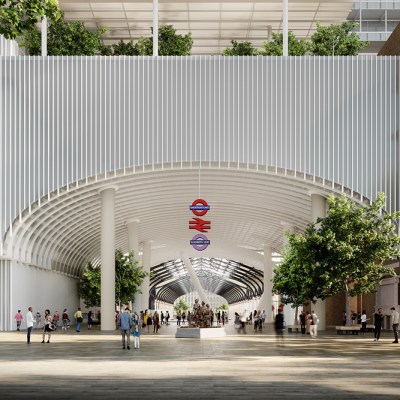As ‘living sculptures’, Gilbert & George have a problem: one day they will die. One day it won’t be them sitting with the builders in a cafe in Spitalfields having breakfast. There will just be students and hipsters in Mangal 1 on Kingsland Road at dinnertime. You won’t be able to spot the couple in their tweed suits walking down Whitechapel Road or any other part of the East End. They won’t be helping out the homeless who sleep near their home on Fournier Street.
Obviously their work, in which they almost always feature themselves, lives on. But these works are spread across the world; in the private collections of the wealthy, or in public galleries, where they could become just another example of Pop art, performance art, or whatever other genre the curator might have assigned them. That doesn’t seem very consistent with the idea of ‘Art for All’ which Gilbert & George profess to stand for.
Photo: Prudence Cuming; courtesy the Gilbert & George Centre

The Gilbert & George Centre, which opened on April Fool’s Day this year, seems like an answer to the problem. Free for the public to enter, it sits in the centre of the East End, the area that has been the backdrop for their daily practice of living sculpture. The bright green, wrought-iron gates of the centre – interwoven with the initials ‘G&G’ – are right next to the Pride of Spitalfields pub, and when I visit, its customers are spilling out across the pavement in the early afternoon sun. A few metres further from the gates is Brick Lane, packed with tourists and the curry houses and shops trying to profit from them. The Brick Lane Mosque is a little further away, and then further again is Shoreditch and Kingsland Road and their bars and clubs with all their patrons from across London and the rest of the world. Over all of this loom the glass towers of the City of London and the scaffolds and cranes of new glass towers being erected. ‘The whole world is here. It’s the centre of the universe here, the East End of London,’ Gilbert explains in a film that plays in the centre’s film room, just inside the green gates.
Before entering the exhibition spaces of the Gilbert & George Centre you walk through a shop stocked with Gilbert & George’s catalogues, prints and painted plates. Just next to the counter, when I visit, is the artist themself, standing in front of a roughly defined queue of visitors who are waiting for their chance to speak with them.
‘I see you everyday, I work in The Ten Bells’ [a nearby pub] one visitor tells them before posing for a picture with them. Another visitor just wants ‘to say thank you for your work’. Gilbert and George greet them all and pose for photo after photo, their familiar, static-dummy expressions occasionally slipping to allow a slight smile.
Installation view of ‘Gilbert & George’s Paradisical Pictures’ at the Gilbert & George Centre. Photo: Prudence Cuming; courtesy the Gilbert & George Centre

The opening exhibition is ‘Gilbert & George’s Paradisical Pictures’, and the centre’s website explains that there will be ‘one or two exhibitions per year showcasing the creations of Gilbert & George’; the centre also commits to working with community and education groups. Even Damien Hirst’s Newport Street Gallery shows the work of other artists (although the last show had Hirst burning his own art just to remind people how much more money he has than everyone else) but, with the Whitechapel Gallery a short walk away, there’s no pressure on the centre to do anything more than show Gilbert & George’s work. Judging by the crowd when I visited, showing Gilbert & George’s work (as well as the artist themself) is enough to justify the new gallery and will sustain their fame and presence in the East End long after they stop working. To that end, a charity has been established to look after the centre and their Fournier Street home when they’re dead. Which should deter would-be developers, hoping to build ‘in a prime location adjacent to the dynamic community of Brick Lane’, for a good while – and when the day finally comes, I’m sure they’ll keep the green G&G gates at least.
The Gilbert & George Centre, London, is open every Friday to Sunday. For more information, click here.


